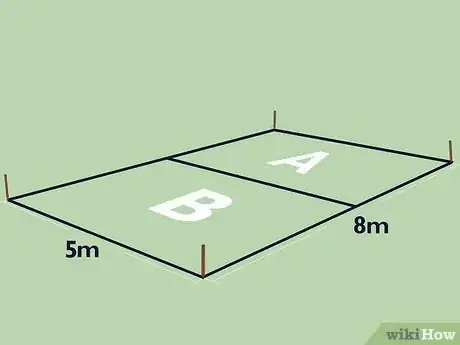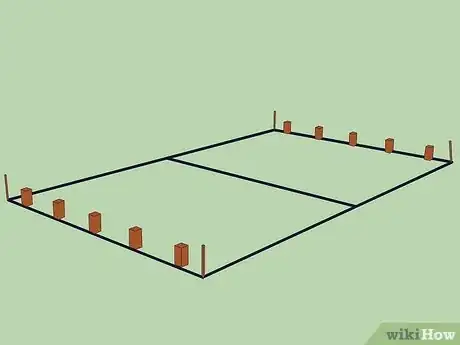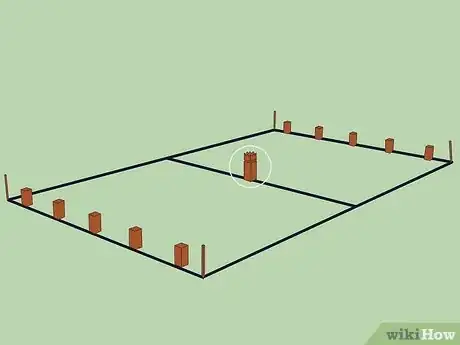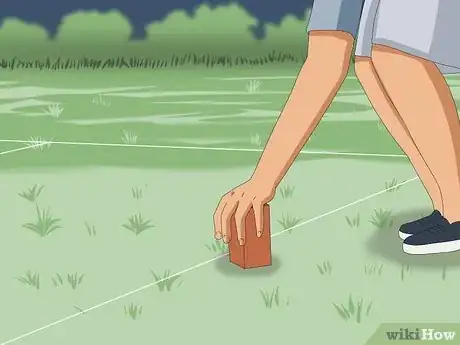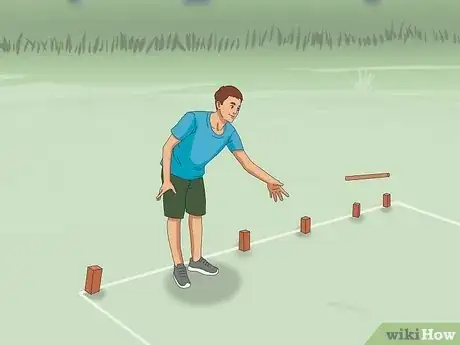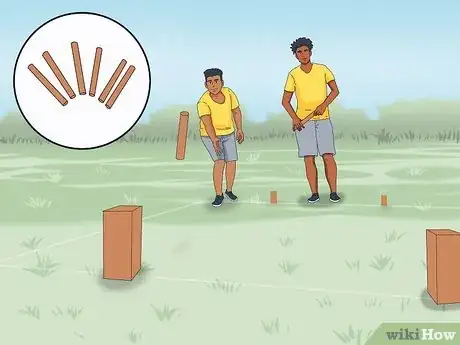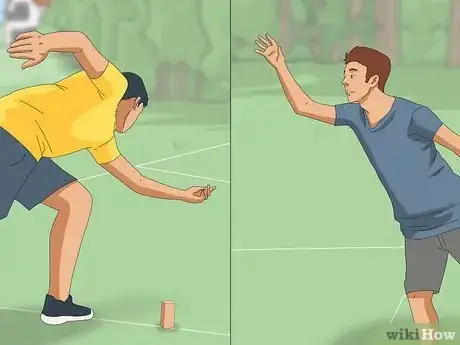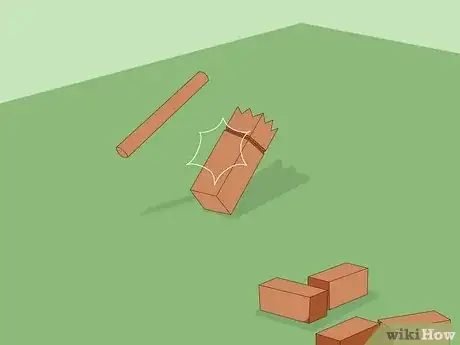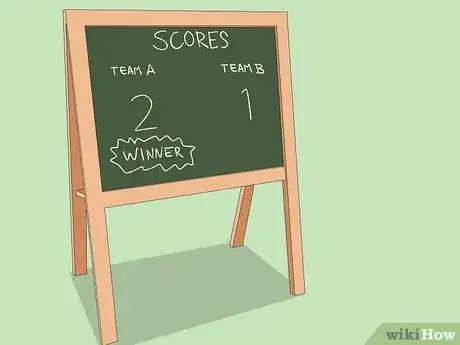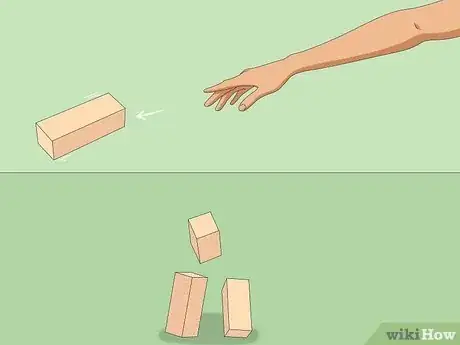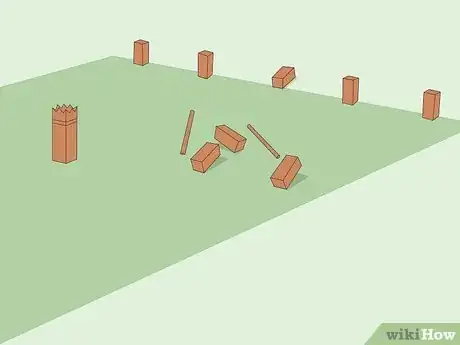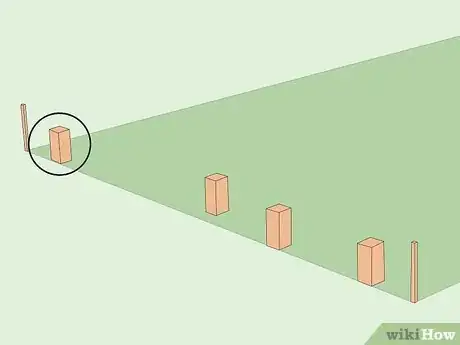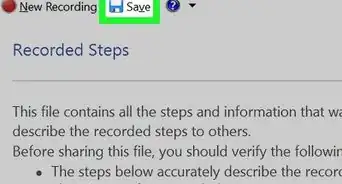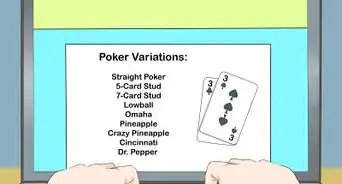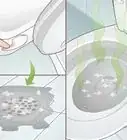This article was co-authored by wikiHow staff writer, Hunter Rising. Hunter Rising is a wikiHow Staff Writer based in Los Angeles. He has more than three years of experience writing for and working with wikiHow. Hunter holds a BFA in Entertainment Design from the University of Wisconsin - Stout and a Minor in English Writing.
There are 13 references cited in this article, which can be found at the bottom of the page.
This article has been viewed 3,331 times.
Learn more...
If you’re looking for a classic lawn game that’s easy to learn but has a lot of strategy, Kubb is the perfect thing to play with your friends and family. In Kubb, or “Viking Chess,” 2 teams try to knock down wooden blocks on the field by tossing batons at them. You can play Kubb with 2–12 people of any age, so it’s perfect for your next outdoor gathering. You’re probably excited to get started, so keep reading for all of the setup and rules you’ll need to play.
Things You Should Know
- The goal of the game is to be the first team to knock over the other team's wooden kubbs and the king.
- Set up a field to play on. Each team will set up 5 kubbs at the edge of their side of the field. Place the king in the middle of the field.
- Determine who goes first by tossing the baton towards the king. The team with the closest baton goes first.
- Toss batons and try to topple the other teams' kubbs. To throw, stand behind the baseline on your team's side, and hold the baton on one end so that it spins vertically in the air.
Steps
Setup
-
1Stake out a field that’s 8 m × 5 m (8.7 yd × 5.5 yd). A Kubb set comes with 4 wooden stakes to mark the corners of the field. Find a flat rectangular area outside and measure out the size of the field, pushing the stakes into the ground at the corners. The short ends of the field are known as the baselines and the longer edges are known as the sidelines.[2]
- Some Kubb sets come with string or rope to loop around the stakes and clearly mark the edges of the field.
- Variation: If you’re playing with kids or want an easier game, make the field 6 by 4 metres (6.6 yd × 4.4 yd) instead.[3]
-
2Stand 5 kubbs up on each baseline between the corner stakes. Kubbs are the 10 rectangular wooden blocks that are 7 by 7 by 15 centimetres (2.8 × 2.8 × 5.9 in).[4] Each team starts the game with 5 kubbs on their side of the field. Evenly space 5 of the kubbs along each baseline at the ends of the field. Leave about 30 centimetres (0.98 ft) of space between the kubbs and the corner stakes.[5]
- The kubbs that are standing on the baseline are called the base kubbs throughout the game.
-
3Place the king in the center of the field. The king is the larger wooden block that has a pointed crown on top. A team needs to knock the king down at the end of the game to win. Find the middle of the field and set the king vertically so the crown is pointing up.[6]
- The king sits on the centerline that runs parallel to the baselines and splits the field into 2 halves. One half of the field belongs to Team A and the other half belongs to Team B.
-
4Determine the starting team by throwing a baton closest to the king. Split into 2 separate teams and choose 1 player to make your starting throw. The chosen players each take 1 of the wooden batons and stand behind the baseline on their side of the field. At the same time, each player tosses the baton with an underhand throw toward the king. The team with the player who threw the baton closest to the king without knocking it over becomes Team A and attacks first. The other team becomes Team B.[7]
- If players tie for the closest, re-throw the batons until there’s a clear winner.
Team B’s First Attack
-
1Team B throws any toppled kubbs onto Team A’s side of the field. If Team A knocked down any kubbs during their turn, Team B picks up the ones that fell over and leaves any that are still standing. Players on Team B stand behind their baseline and take turns tossing the kubbs onto Team A’s side of the field with an underhand throw.[9]
- Players have to knock down the kubbs that they just threw, so try to land them in a spot you think will be easy to hit with batons later on.
- If a kubb goes out of bounds or doesn’t cross the centerline, players get one more chance to throw it in bounds. If it still lands on the wrong side of the field or out of bounds, it becomes a penalty kubb and Team A can place it wherever they want on their side of the field.
-
2Team A raises the kubbs that were just thrown so they stand vertically. After Team B tosses the kubbs, Team A goes out into the field and stands them up vertically. They can choose to tip the kubb onto either end as long as it stays in bounds. The kubbs that are in the field instead of on the baseline are now called field kubbs.[10]
- If a kubb hits another one already in the field when it’s thrown, stand both of them up where they come to rest.
- If a thrown kubb knocks over a base kubb, return the base kubb to its original position standing up.[11]
-
3Team B tosses 6 batons to knock down the kubbs on Team A’s side. Just like Team A’s first attack, Team B stands behind the baseline on their side of the field while they throw batons. Players should aim for the field kubbs on Team A’s side first. Then the players try to hit the kubbs that are still on the baseline.[12]
- If a player knocks over a base kubb before toppling all of the field kubbs, the throw doesn’t count and Team A stands the kubb back up in its original position.
Warnings
References
- ↑ https://www.kiwicamping.co.nz/Documents/4882_Kubb%20Instruct.pdf
- ↑ https://www.kubbvm.com/rules/english.pdf
- ↑ https://cdn.moble.com/w/660/127751/file/Kubb-Rule-Card-10-JUN-2014.pdf
- ↑ https://www.kubbvm.com/rules/english.pdf
- ↑ https://youtu.be/ffJB_31TS_8?t=17
- ↑ https://www.kiwicamping.co.nz/Documents/4882_Kubb%20Instruct.pdf
- ↑ https://static1.squarespace.com/static/55ba12b5e4b0f2c56aefa88b/t/55d25512e4b06f52f9e7b0e8/1439847698320/UK_National_Kubb_Championship_Rules_v0-3.pdf
- ↑ https://gameshire.com.au/wp-content/uploads/2014/11/Kubb.pdf
- ↑ https://static1.squarespace.com/static/55ba12b5e4b0f2c56aefa88b/t/55d25512e4b06f52f9e7b0e8/1439847698320/UK_National_Kubb_Championship_Rules_v0-3.pdf
- ↑ https://www.kubbvm.com/rules/english.pdf
- ↑ https://www.kiwicamping.co.nz/Documents/4882_Kubb%20Instruct.pdf
- ↑ https://gameshire.com.au/wp-content/uploads/2014/11/Kubb.pdf
- ↑ https://www.kiwicamping.co.nz/Documents/4882_Kubb%20Instruct.pdf
- ↑ https://static1.squarespace.com/static/55ba12b5e4b0f2c56aefa88b/t/55d25512e4b06f52f9e7b0e8/1439847698320/UK_National_Kubb_Championship_Rules_v0-3.pdf
- ↑ https://youtu.be/ffJB_31TS_8?t=70
- ↑ https://gameshire.com.au/wp-content/uploads/2014/11/Kubb.pdf
- ↑ https://www.kiwicamping.co.nz/Documents/4882_Kubb%20Instruct.pdf
- ↑ https://www.cadl.org/application/files/4115/5628/9887/Kubb_Rules.pdf
- ↑ https://ohiokubb.com/penalty-kubb-placement-strategy/
- ↑ https://gameshire.com.au/wp-content/uploads/2014/11/Kubb.pdf
- ↑ https://www.kubbeurope.com/wp-content/uploads/2019/02/EKC_2018_Ruleset_1.0_ekc.pdf

